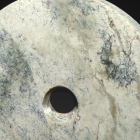J.J. Lally & Co., Oriental Art / New York City, New York
MenuPast Exhibition
Ancient Chinese Jade
March 15-29, 2018
28.
A NEOLITHIC CLOUDY GRAY-GREEN JADE DISC (BI)
Liangzhu Culture, circa 3300-2250 B.C.
with thick sides and squared flat outer edge, smoothly polished all over, the small central aperture drilled from both sides and with a narrow crescent-shaped ledge remaining in the middle, the cloudy gray-green stone with darker green mottling throughout.
Diameter 4 7⁄8 inches (12.2 cm)
Ex J.J. Lally & Co., 1994 catalogue no. 18
Compare the Liangzhu bi disc of slightly larger size unearthed from the Xin’anqiao site, Deqing, Zhejiang province, now in the Deqing Museum, illustrated by Gu (ed.), Zhongguo chutu yuqi quanji (Complete Collection of Jades Unearthed in China), Vol. 8, Zhejiang, Beijing, 2005, p. 39. Another similar Neolithic jade bi disc of smaller size is illustrated by Loehr, Ancient Chinese Jades from the Grenville L. Winthrop Collection in the Fogg Art Museum, Harvard University, Cambridge, 1975, p. 37, no. 7.
The bi disc was an essential element of Liangzhu burial rituals. Important Liangzhu burials often contain several bi of various sizes including very large examples. Archaeological reports indicate that the majority of the bi discs found in a tomb are roughly cut and unevenly ground, with only one or two examples in each burial showing the finely finished details and highly polished surface of the present example which would require a high degree of skill and much greater time and effort to produce.
新石器時代 良渚玉璧 徑12.2厘米
來源 藍理捷1994特展圖錄第18號
